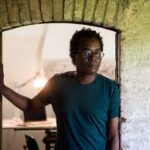Agorà
permanent sound installation
OPENArchival Platform
M’barek Bouhchichi

Visual artist
Born in 1975, Akka, Morocco, he lives and works in Tahanaout next to Marrakech where he teaches art. Using painting, sculpture, drawing or even video, M’barek Bouhchichi develops his work through a tentative language grounded on the exploration of the limits between our internal discourse and its extension towards the outer world, the actual, the other. He places his works at the crossroad between the aesthetic and the social, exploring associated fields as possibilities for self-definition.
Recently, his work has been exhibited as a solo show Les mains noires (Kulte, Rabat, Morocco, 2016), as collective exhibition Documents bilingues (MUCEM, Marseille, France, 2017), as well as Le Maroc contemporain (Institut du Monde Arabe, Paris, France, 2014), Between walls (Le 18, Marrakech, Morocco, 2017).
Born in 1975, Akka, Morocco, he lives and works in Tahanaout next to Marrakech where he teaches art. Using painting, sculpture, drawing or even video, M’barek Bouhchichi develops his work through a tentative language grounded on the exploration of the limits between our internal discourse and its extension towards the outer world, the actual, the other. He places his works at the crossroad between the aesthetic and the social, exploring associated fields as possibilities for self-definition.
Recently, his work has been exhibited as a solo show Les mains noires (Kulte, Rabat, Morocco, 2016), as collective exhibition Documents bilingues (MUCEM, Marseille, France, 2017), as well as Le Maroc contemporain (Institut du Monde Arabe, Paris, France, 2014), Between walls (Le 18, Marrakech, Morocco, 2017).
Black History Month Florence 2020
An exhibition that examines the implementation of social obligations towards dirty work, the shortcomings of cultural assimilation, the silencing of histories and the politics of respectability.
The artists in the exhibition each draw upon experiences of a periods of permanence in Italy that pushes them to engage the cities of Rome, Umbertide, Milan and Florence as sites for cultural production with the need to engage history while not falling victim to it.
Activist Pape Diaw, in a 2013 interview spoke of “…sporcarsi le mani per fare un lavoro pulito “, literally getting our hands dirty to do a clean job. This contradiction is at the core of a social context where dirty work is engaged in to maintain a status governed by the politics of respectability and social policing.
The exhibition, curated by Black History Month Florence, as part of the 5th edition of BHMF, in collaboration with Villa Romana (Florence), Civitella Ranieri Foundation (Umbertide) and Galleria Continua (San Gim
An exhibition that examines the implementation of social obligations towards dirty work, the shortcomings of cultural assimilation, the silencing of histories and the politics of respectability.
The artists in the exhibition each draw upon experiences of a periods of permanence in Italy that pushes them to engage the cities of Rome, Umbertide, Milan and Florence as sites for cultural production with the need to engage history while not falling victim to it.
Activist Pape Diaw, in a 2013 interview spoke of “…sporcarsi le mani per fare un lavoro pulito “, literally getting our hands dirty to do a clean job. This contradiction is at the core of a social context where dirty work is engaged in to maintain a status governed by the politics of respectability and social policing.
The exhibition, curated by Black History Month Florence, as part of the 5th edition of BHMF, in collaboration with Villa Romana (Florence), Civitella Ranieri Foundation (Umbertide) and Galleria Continua (San Gimignano), presents the work of 6 international artists who have used the Italian context as a place of artistic production. A series of transversal works leads to a reworking of stereotyped notions of Made in Italy that tend to exclude Afro-descendents, revealing colonial attitudes and inviting and breaking preconceptions.
An insistence on personal narratives as an override to the flattened projections of Blackness, the construction of bridges between a colonial past and a neo-colonial contemporary reality and the ethereality of monumentality all infuse these works with a meditation on the past as a marker of what’s to come.
Together they form a harmonic melody that is discordant with the prescribed, centralized, consumed narrative but finds just enough alignment to relay its power to enrich the age-old tune
Available in: